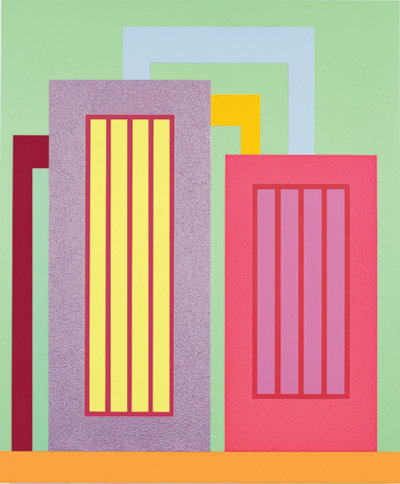Peter Halley
dal 30/5/2007 al 29/6/2007
Segnalato da
30/5/2007
Peter Halley
Waddington Custot Galleries, London
8 new paintings, whose each component (Background, Cell or Prison, Window, Bars, connecting Conduits) is painted in a single solid vibrant colour. Several references influence approach and the iconography behind his painting, among which Michael Foucault's Discipline and Punish, the concrete experience of New York, the city designed on a grid, and Josef Albers's Interaction of Color whilst at Phillips Academy in Massachusetts.

Solo show
"Here, the idealist square becomes a Prison. Geometry is revealed as confinement." (Peter Halley Collected Essays 1981-1987. Notes on the paintings (1982) p.23)
Waddington Galleries are pleased to announce an exhibition of eight new paintings by Peter Halley.
The components of each are: Background, Cell or Prison, Window, Bars, connecting Conduits. Each component is painted in a single solid vibrant colour. In Edukators two elongated prisons stand apart in their own solitary incarceration. Large and small, they resemble a family pairing of neon barcodes, linked only by arm-like channels.
A primary influence on the iconography behind Halley's painting was Michael Foucault's Discipline and Punish - a discourse of how Jeremy Bentham's blueprint for a panoptical prison (multiple isolated cells visible from a central tower) has permeated every institutional disciplinary aspect of society. But Halley's work is also rooted in a more concrete experience of New York, the city designed on a grid. In the early 1980s Halley lived in a building on 7th Street where the ground floor was a pub that had a stucco façade and windows with bars fitted over them; unconsciously he had been walking past his central motif every day. Stucco is often used to cover ageing walls of unloved buildings and Halley replicates this texture in his work using Roll-a-Tex paint.
Since 1994 Halley has used the computer as a compositional tool. As communication networks have become more complex and intertwined, so the connecting imagery in Halley's work has become more elaborate. In each painting the cells are linked by two conduits, suggesting a current of material, an outflow and an inflow. This not only alludes to the distribution and organisation of people, but also how we simulate and process the elements - our water from tank to sink, air from tube to vent, heat from pipe to grill and our proliferating network of electronic data. In Channels the rectangular cells are aligned horizontally, resembling two monitors. The Pearl-Tex paint appears to visually hum like a television's end-signal having lost transmission.
Halley read Josef Albers's Interaction of Color whilst at Phillips Academy in Massachusetts, 1967-71, and it has remained influential in his approach. Colour carries its own cultural etiquette and Halley does not bestow a false grandeur or illusionary seriousness by evoking the sombre colours of the Old Masters. His striking uses of pure colour in paintings such as Mirror contain the primary palette of childhood building blocks; a pick-n-mix heraldic display of synthetic consumerism, a pageant of Pearlescent and Day-Glo acrylic.
Peter Halley was born in New York City in 1953 and was educated at Yale University, 1975 and University of New Orleans, 1978. He came to critical attention in the early 1980s as part of a group known as the Neo-Geometric Conceptualists, which included Jeff Koons and Ashley Bickerton. It was Halley's own writing, inspired by Jean Baudrillard's theory of simulation, which became the group's theoretical force. In 1986 Andy Warhol painted a series of portraits of Halley. He has had annual international one person exhibitions since 1984 including the Museum Folkwang Essen, Germany in 1998 and Louisiana Art & Science Museum, Los Angeles in 2005. Between 1996 and 2005 Halley published the cultural magazine Index from his studio in Chelsea, New York.
A fully illustrated catalogue accompanies the exhibition.
In association with Waddington Galleries, Peter Halley will also be exhibiting at Stuart Shave / Modern Art from 31st May.
Waddington Galleries
11 Cork Street - London
Gallery hours: Monday 10am-6pm, Saturday 10am-1.30pm



